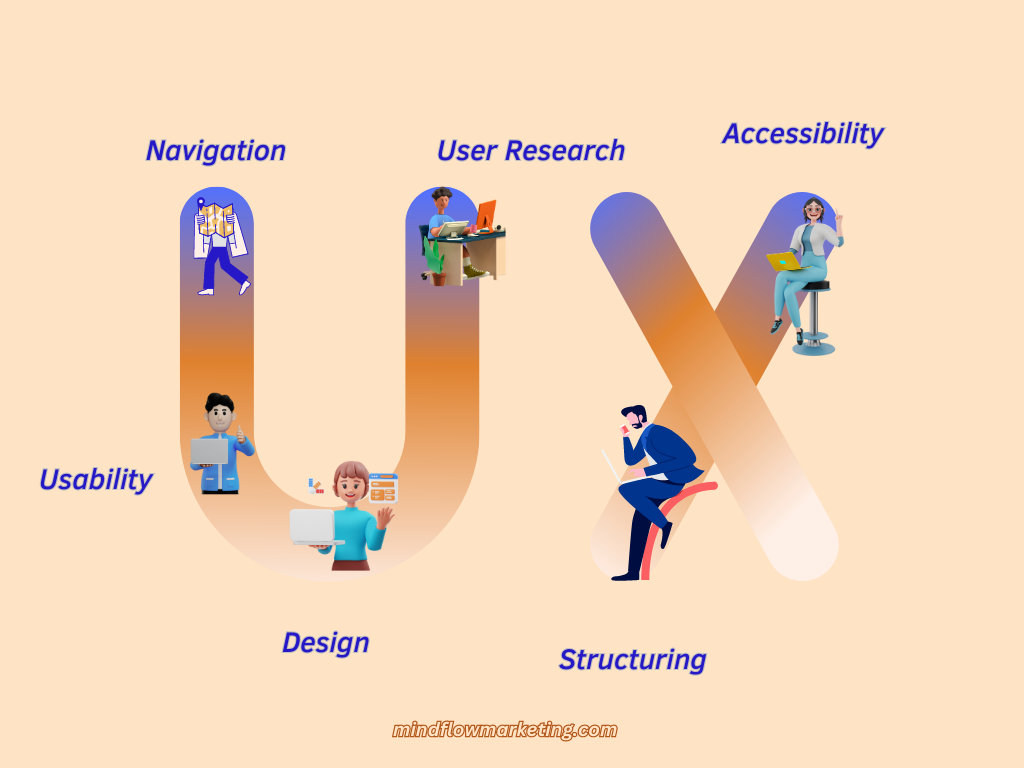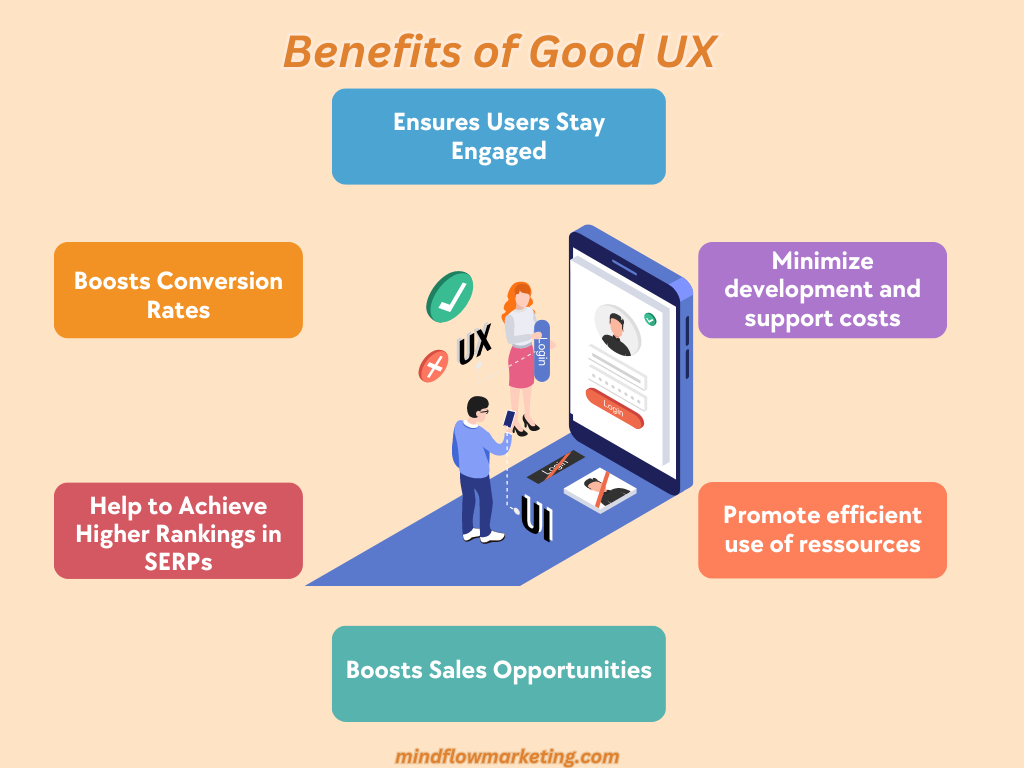As a UX professional with many years of expertise, I’ve encountered numerous false beliefs concerning user experience. In this blog post, we’ll explore the truth behind some of the most common UX myths and arm you with the knowledge and benefits of creating optimal experiences for your users.
In short, by reading this post, you will gain valuable insights into common UX myths and learn practical ways to enhance your design process through conducting user research while keeping business objectives in mind as well as effectively conducting usability testing sessions for optimal results.

More Resources :
What is UX?
UX, or User Experience, is the art of designing products and services that offer users purposeful and pertinent experiences. It’s about understanding how people interact with your website or app and making sure it meets their needs in a way that feels natural. UX is an integral part of any successful online business as it directly impacts user engagement and conversions.

When designing for UX, you need to consider how each element on your page contributes to the overall experience. This includes everything from navigation menus to fonts, images, videos, and more. You should also think about how users will interact with each element—what they expect when they click on something or type into a search bar.
The goal of good UX design is to make sure that visitors can easily find what they’re looking for without getting frustrated by confusing interfaces or slow loading times. When done right, this creates a positive user experience which leads to increased customer satisfaction—and ultimately higher conversion rates.
Common Myths about UX
There are many misconceptions about user experience (UX) that can lead to poor design decisions. Here we will look at some of the most common myths and why they should be avoided.

Myth 1: UX is All About Making Things Pretty
Though visuals may be influential in crafting an enjoyable user experience, usability and functionality are just as critical to consider when designing for UX. While aesthetics certainly play an important role in creating an engaging user experience, it’s only part of the equation – usability and functionality are equally important considerations when designing for UX.
Myth 2: You Don’t Need to Invest in UX if You Have a Great Product/Service
Many businesses assume that the quality of their product and services is enough to speak for itself; however, this assumption could not be more wrong. Failing to account for user requirements in the design process can result in a lack of intuitive navigation or usability, potentially leading to lost customers who find your product/service too complicated.
Myth 3: Good UI = Good UX
A well-designed User Interface (UI) does not automatically guarantee a great user experience; instead, it should complement other aspects such as navigation flow, content structure, and overall functionality for users to enjoy using your product or service over time. It’s also worth noting that while UI focuses on how elements appear visually on screen, UX encompasses all aspects including performance speed and accessibility requirements across different devices – something which UI alone cannot provide.
Rather than relying exclusively on user feedback, it is important to use it as one tool among many when designing websites. This will help ensure that the experience meets expectations and provides valuable insight into areas where improvements may be necessary to better serve a variety of users. It is essential not to let individual preferences take precedence over achieving overall usability goals.
Myth 4: You Are Like Your Users
The False-Consensus Effect is a common bias among designers who assume that all users think and behave like themselves when creating a website. This can lead to an inefficient design that fails to meet the needs of the intended audience. To prevent this from happening it is essential to actively seek out and learn about your users to create a design tailored to them.
Overcoming the Bias requires understanding your user’s knowledge level and motivation for using your site or services. Involve your clients in the design process by asking questions such as “What do you need?” or “How can I make this easier?” this will help ensure that their needs are met while also helping reduce any potential biases on your part.
Myth 5: The Homepage is Your Most Important Page
In recent years, user behavior has changed significantly when it comes to browsing and searching for content on websites. People are no longer starting their journey from the homepage; instead, they’re going directly to specific pages that offer what they need or want at any given time. This shift has resulted in a decrease in pageviews for many home pages compared to other pages within the website. For example, an e-commerce store may see more pageviews on its product pages than on its homepage because users are skipping over the homepage and going straight to the products they’re interested in buying.
How to Improve Your Website’s UX
User experience (UX) is a crucial part of any website, and it’s essential to ensure that your site provides the best possible UX. To ensure your website provides the best possible user experience, optimize its design by ensuring quick loading times and an intuitive content organization.
Quick page loading is essential – no more than a few seconds should be spent waiting for a page to appear. Optimize images and use caching techniques like browser caching or server-side caching when appropriate.
Ensure that users can quickly pinpoint their desired content by supplying intuitive navigational elements, including menus, search fields, and breadcrumbs so they are always aware of where they stand within the website’s structure.
Too many elements on a single page can be overwhelming for users; simplify things by using white space effectively and reducing clutter wherever possible – this will help draw attention to key areas of interest on each page as well as increase readability overall.
Put important information first so users don’t have to sift through lots of unnecessary content before finding what they need – organize text into logical sections with headings so readers can quickly scan pages if needed. Additionally, break up long pieces of text with visuals such as images, videos, or infographics.
Web designers and developers should reevaluate how much time and effort is spent designing and optimizing the homepage as opposed to other important pages such as product or category pages on an e-commerce site or blog posts on a blog site.
While it’s still important to have an attractive and functional homepage that accurately reflects your brand identity, there is no greater value placed on optimizing other areas of your website that get more direct traffic from users who already know what they’re looking for before arriving at your site.
The key is to stay consistent, homepages tend to have a higher bounce rate due to users quickly glancing at them before leaving, but this does not necessarily mean those visitors were without value. It is conceivable some may be studying up on competitors or collecting data about your business before making an eventual purchase decision elsewhere down the line which could still benefit you tangentially through amplified brand recognition and cognizance even if it doesn’t immediately lead to sales.
Consequently, investing resources into designing attractive landing pages with well-defined calls-to-action can help capture leads even when people don’t make purchases right away – something which has the potential for great benefits in the long run depending on how your company operates.
Good UX design starts with thorough research into who your target audience is and what their goals are when visiting your site. Once you have an understanding of these things you can start building wireframes that map out where different elements will go on the page (such as buttons, forms, etc.). From there it’s just a matter of adding visuals such as colors and fonts until you have something that looks great but still provides easy access for all types of users regardless of device size or abilities.
It’s important not to forget usability testing throughout the process too; this helps ensure that everything works properly before launch day arrives. A/B testing tools can also be used after launch so you can track visitor behavior over time – helping identify areas where improvements could be made if needed.
Benefits of Good UX
Good user experience (UX) design is essential for any website or app. It’s the foundation of a successful online presence, and it can make or break your success. The benefits of having a good UX design are numerous.

UX focuses on making sure users have an enjoyable, efficient, and effective experience when interacting with your site. A successful UX ensures visitors stay engaged while allowing them to effortlessly access the desired content. Having a great user experience increases engagement levels as visitors feel compelled to stay longer on the page because everything works smoothly and looks aesthetically pleasing.
The most important benefit is that it helps increase conversion rates by making it easier for customers to complete their desired action without frustration or confusion. For example, if you’re running an e-commerce store, good UX will help customers find what they’re looking for faster so they can purchase items quickly and efficiently.
SEO-friendly web design will also help you achieve higher rankings in organic search results pages (SERPs), driving more potential customers to your business without relying heavily on costly paid ads. Additionally, a great user experience also helps reduce customer service costs as fewer people will be calling in asking questions about how to navigate the site due to its intuitive design.
An attractive and straightforward UX can create an atmosphere of trustworthiness, allowing users to make decisions with confidence regarding whether or not they should purchase from your company. This could lead directly to additional sales opportunities depending upon how targeted content/products are presented within each page layout accordingly.
Gleaning Insights for Effective UX Design
Measuring success when it comes to website user experience (UX) design is essential for any business. Gleaning insights into the efficacy of UX design necessitates collecting and studying data from a range of sources, like analytics programs, customer surveys, feedback, and usability tests.
Analytics tools are the most common way to measure success with website UX. These tools can furnish you with precious information on how guests interact with your websites, such as page visits, length of stay, and bounce rates. This data can help you identify areas that need improvement or redesigns that have been successful.
Gathering user feedback through surveys can provide insight into how users perceive the navigation, content, and overall satisfaction of your website. You can ask them questions about ease of navigation, content relevance, and overall satisfaction with the user experience they had while visiting your website. Analyzing survey results will give you an idea of where improvements should be made or what features may need further development to enhance the user’s experience even more.
FAQs Concerning UX & Conversions Myths: Facts and Legends
Conclusion
In conclusion, UX and conversions are an important part of any website. To maximize the potential of UX and conversions, it is essential to understand both fact-based research and anecdotal evidence. With proper research into the topic of UX & conversions myths: legends and facts, you can ensure success on all levels with increased traffic and higher conversion rates from customers who have had positive experiences while navigating through your site.
Discover how to maximize your search engine visibility and increase conversions through UX optimization. Learn the myths, legends, and facts about SEO, site architecture, web usability & user experience now!